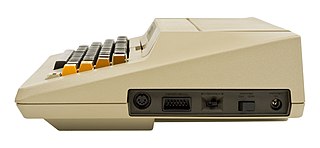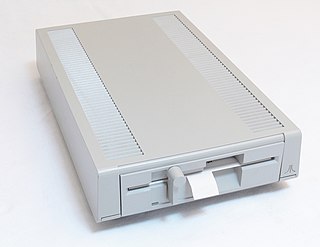
The Commodore 1541 is a floppy disk drive which was made by Commodore International for the Commodore 64 (C64), Commodore's most popular home computer. The best-known floppy disk drive for the C64, the 1541 is a single-sided 170-kilobyte drive for 5¼" disks. The 1541 directly followed the Commodore 1540.

The Commodore 1571 is Commodore's high-end 5¼" floppy disk drive, announced in the summer of 1985. With its double-sided drive mechanism, it has the ability to use double-sided, double-density (DS/DD) floppy disks, storing a total of 360 kB per floppy. It also implemented a "burst mode" that improved transfer speeds, helping address the very slow performance of previous Commodore drives.

A floppy disk or floppy diskette is a type of disk storage composed of a thin and flexible disk of a magnetic storage medium in a square or nearly square plastic enclosure lined with a fabric that removes dust particles from the spinning disk. The three most popular floppy disks are the 8-inch, 5¼-inch, and 3½-inch floppy disks. Floppy disks store digital data which can be read and written when the disk is inserted into a floppy disk drive (FDD) connected to or inside a computer or other device.

The Atari 8-bit computers, formally launched as the Atari Home Computer System, are a series of home computers introduced by Atari, Inc., in 1979 with the Atari 400 and Atari 800. The architecture is designed around the 8-bit MOS Technology 6502 CPU and three custom coprocessors which provide support for sprites, smooth multidirectional scrolling, four channels of audio, and other features. The graphics and sound are more advanced than most of its contemporaries, and video games are a key part of the software library. The 1980 first-person space combat simulator Star Raiders is considered the platform's killer app.

The ST-506 and ST-412 were early hard disk drive products introduced by Seagate in 1980 and 1981 respectively, that later became construed as hard disk drive interfaces: the ST-506 disk interface and the ST-412 disk interface. Compared to the ST-506 precursor, the ST-412 implemented a refinement to the seek speed, and increased the drive capacity from 5 MB to 10 MB, but was otherwise highly similar.

Atari DOS is the disk operating system used with the Atari 8-bit computers. Operating system extensions loaded into memory were required in order for an Atari computer to manage files stored on a disk drive. These extensions to the operating system added the disk handler and other file management features.
Optimized Systems Software (OSS) was a company that produced disk operating systems, programming languages with integrated development environments, and applications primarily for Atari 8-bit computers. The founders of OSS previously developed Atari DOS, Atari BASIC, and the Atari Assembler Editor for Atari, Inc., and many OSS products are substantially improved versions. OS A+ and DOS XL are based on Atari DOS. BASIC A+, BASIC XL, and BASIC XE are based on Atari BASIC. EASMD and MAC/65 are modeled on the Atari Assembler Editor. Action! is an ALGOL-inspired compiled programming language with an integrated full-screen editor. OSS also sold some software for the Apple II.

The Disk II Floppy Disk Subsystem, often rendered as Disk ][, is a 5 +1⁄4-inch floppy disk drive designed by Steve Wozniak at the recommendation of Mike Markkula, and manufactured by Apple Computer It went on sale in June 1978 at a retail price of US$495 for pre-order; it was later sold for $595 including the controller card and cable. The Disk II was designed specifically for use with the 1977 Apple II personal computer to replace the slower cassette tape storage.
Atari 8-bit computer peripherals include floppy drives, printers, modems, and video game controllers for Atari 8-bit computers, which includes the 400/800, XL, XE, and XEGS.

FileWare floppy disk drives and diskettes were designed by Apple Computer as a higher-performance alternative to the Disk II and Disk III floppy systems used on the Apple II and Apple III personal computers. The drive is named Apple 871 in service documentation, based on its approximate formatted storage capacity in kilobytes, but is most commonly known by their codename Twiggy, after the famously thin 1960s fashion model named Twiggy.

A floppy disk is a disk storage medium composed of a thin and flexible magnetic storage medium encased in a rectangular plastic carrier. It is read and written using a floppy disk drive (FDD). Floppy disks were an almost universal data format from the 1970s into the 1990s, used for primary data storage as well as for backup and data transfers between computers.
Happy drives are series of disk drive enhancements for the Atari 8-bit and Atari ST computer families produced by a small company called Happy Computers. Happy Computers is most noted for the add-in boards for the Atari 810 and Atari 1050 floppy disk drives, which achieved a tremendous speed improvement for reading and writing, and for the ability to backup floppies. Happy's products were among the most popular Atari computer add-ons. They were still in use and active in the aftermarket as of 2009.

The floppy disk is a data storage and transfer medium that was ubiquitous from the mid-1970s well into the 2000s. Besides the 3½-inch and 5¼-inch formats used in IBM PC compatible systems, or the 8-inch format that preceded them, many proprietary floppy disk formats were developed, either using a different disk design or special layout and encoding methods for the data held on the disk.
The Indus GT is a 5+1⁄4-inch floppy disk drive that was introduced by Indus Systems in 1983 for the Atari 8-bit computers. It was later released for the Apple II and Commodore 64. On the Atari, it was widely regarded as the best drive of the era, with the most features, highest performance, and even best industrial design. They were known for the advertising slogan, "Turn your Atari into a Ferrari." The GT was sold until around 1987, at which point the rights were sold to Logical Design Works and reintroduced as the LDW Super 2000, sold primarily into Poland, and the CA-2001, sold into the US.

The Serial Input/Output system, universally known as SIO, was a proprietary peripheral bus and related software protocol stacks used on the Atari 8-bit computers to provide most input/output duties for those computers. Unlike most I/O systems of the era, such as RS-232, SIO included a lightweight protocol that allowed multiple devices to be attached to a single daisy-chained port that supported dozens of devices. It also supported plug-and-play operations. SIO's designer, Joe Decuir, credits his work on the system as the basis of USB.

The Atari 1050 is a floppy disk drive for Atari 8-bit computers released in June 1983. It is compatible with the 90 kB single-density mode of the original Atari 810 it replaced, and added a new "enhanced" or "dual density" mode that provided 130 kB. Based on a half-height Tandon mechanism, it was smaller than the 810 and matched the styling of the new 600XL and 800XL machines.

Announced on May 17, 1982, the SMC-70 is a microcomputer that was produced by Sony and released in September 1982. The system was initially released for general office use in the United States, with the SMC-70G and SMC-70GP designed for professional video generation, for example in cable television applications, and digital video effect generation.

Percom Data Corporation was an early microcomputer company formed in 1976 to sell peripherals into the emerging microcomputer market. They are best known for their floppy disk systems, first for S-100 machines, and the later for other platforms like the TRS-80 and Atari 8-bit computers. The company was purchased by Esprit Systems in 1984.

The XF551 is a 5 1/4 inch floppy disk drive produced by Atari, Inc. for the Atari 8-bit computers. Introduced in 1987, it matches the gray design language of the XE models. It was the first drive from the company with official support for double-density and double-sided floppy disks—360 kB of storage per disk—and was also the final floppy disk drive Atari produced for the 8-bit computers. The XF551 allows faster transfer speed when used in double-density mode, doubling performance.

Atari Word Processor is a word processor program for the Atari 8-bit computers, announced by Atari, Inc. in January 1981 and shipped that summer. The program was powerful for its era, including numerous features like superscripts and two-column layouts. It was also quite complex, with a long list of control keys for basic operations and text-based menus for more complex ones. It left little memory free after loading, so longer documents had to be stored as separate files of about a page each and printing demanded a long re-formatting process as they were stitched together.


















